Gum disease can be a very debilitating condition to live with. Many people struggle with gum disease in the modern age, despite advancements in oral health. Now, Japanese researchers have analysed teeth from the skeletons of people that lived around 400 years ago. They found that levels of gum disease have largely stayed the same. However, bacteria types have changed a lot in that time.
Japanese researchers have completed a study that analyzed the teeth of 12 human skeletons from the 1600s. The study looked to analyze how levels of gum disease have changed in that time. Moreover, they also wanted to detect which types of bacteria were present in the 1600s.
The researchers believed this would give them an insight into the oral health of Japanese citizens 400 years ago. By looking at bacterial and gum disease trends, the researchers also hoped that it would help them with future research directions.
Background
The study involved skeletons from Japan’s Edo era. The Edo era refers to Japan’s history between the 1600s and the mid-1800s. The Edo era is viewed as a successful time in Japan’s history [1]. Therefore, Japanese citizens at the time were able to have a regular diet.
In terms of oral health, the use of fluoride in recent decades has been a significant benefit to oral health. However, unlike in the 1600s, there is a vast array of high sugar and calorific foods, which have led to high rates of obesity. Therefore, despite the improvements in dental care, gum disease rates continue to rise, due in part to our diet. Sugar consumption, smoking and genetics are all risk factors.
Gum disease is a condition that can cause many problems. The condition is caused by an accumulation of dental plaque, which results in inflammation and eventual bone destruction [2]. Gum disease is the most common cause of tooth loss in adults [3].
The Research
The research was carried out by the Tokyo Medical and Dental University (TDMU). Their findings were then published in the journal Frontiers in Cellular and Infection Microbiology [4].
The researchers used the teeth of 12 human skeletons from Japan’s Edo era. The teeth came from humans that lived between 1603 and 1687 [4].
The researchers were attempting to find out about which types of bacteria were present in the 1600s, and see the subsequent levels of gum disease. In order to do this, the researchers used a new method to diagnose gum disease in skeletons.
This method abandoned the usual approach of extracting teeth from the jawbone as a means of finding out the level of bone loss and resulting level of gum disease. Instead, advancements in computing allowed the researchers to find out the level of bone loss without physically removing the teeth from skeletons [4]
The researchers detected gum disease in 5 of the 12 skeletons. Therefore, gum disease was present in approximately 42% of the skeletons [4]. This was a higher amount than the researchers had expected [4].
The researchers then contrasted those findings with that of a large study in 2005 that focused on the oral health of the Japanese population. That study found that 37% of Japanese citizens in their 40s suffered from gum disease [5]. So while there were similar levels, it turned out that rates were actually lower in the modern day.
The authors also found that different types of bacteria were present in the 1600s, in comparison to the modern day. For instance, more severe and damaging types of bacteria weren’t found in the skeletons [4]. Instead, the damaging bacteria, known as the “red complex”, was common in the modern-day [4].
What this means
The findings were somewhat surprising. Despite the improvements in oral health provisions, the fact that the modern-day diet is high in sugar consumption meant that researchers expected gum disease levels to be lower in the skeletons. But this was not the case. However, the rates were very similar, suggesting that the variables in play cancelled one another out.
The technological advancements used within this study excited researchers. Senior author Takahiko Shiba said that their new method of analyzing the teeth of skeletons was very promising [6]. Moreover, Shiba said “with advancements in micro-computed tomography technology, we were able to accurately quantify bone loss without removing teeth from the skeletons” [6].
As for future research directions, the findings in this study could be used for models predicting future trends in gum disease and types of bacteria.
Thinking points…
1) Many people struggle to sleep properly. But instead of trying radical approaches like mouth taping, why not visit your local dentist to see if they can suggest any improvements in sleep hygiene or oral health?
2) There can be underlying dental conditions that cause problems with sleep. By visiting your Calgary dentist for a regular check-up, any issues will be able to be identified and then treated.
3) Do you have children? If so, it is worth checking in with them on supposed “dental hacks”, so that they don’t act in a way that will cause them significant problems.
What we offer at Taradale Dental
Taradale Dental is a Calgary Dental clinic that provides a warm welcome, a comfortable experience and advice to its patients, whenever is needed.
We recommend that our patients attend our Calgary-based dental clinic twice a year for a regular dental check-up. When problems are detected, we have many treatments available. For instance, these include cavity fillings and root canals. We also provide cosmetic dental treatments too!
Importantly, we recommend brushing your teeth at least twice a day and flossing regularly. Moreover, eating healthily and trying to avoid sugary foods and drink is helpful.
In addition, all of our services at our Calgary dental clinic Taradale Dental are in line with the Alberta Dental Fee Guide.
We would love you to visit our Taradale Dental dental clinic in Calgary! You can find out more about us by visiting our website https://taradaledental.ca.
References
[1] Spacey, J. (2015). The Edo-era: Japan’s Golden Age. Available: https://www.japan-talk.com/jt/new/edo-era-in-Japan. Last accessed: 23rd December 2021.
[2] Kinane, D. F., Stathopoulou, P. G., Papapanou, P. N. (2017). Periodontal Diseases. Nature Reviews Disease Primers. 22 (3): p17038-17051.
[3] Burt, B. (2005). Position Paper: Epidemiology of Periodontal Diseases. Journal of Periodontology. 76 (8): p1406–1419.
[4] Shiba, T., Komatsu, K., Sudo, T., Sawafuji, R., Saso, A., Ueda, S., Watanabe, T., Nemoto, T., Kano, C., Nagai, T., Ohsugi, Y., Katagiri, S., Takeuchi, Y., Kobayashi, H., & Iwata, T. (2021). Comparison of Periodontal Bacteria of Edo and Modern Periods Using Novel Diagnostic Approach for Periodontitis With Micro-CT. Frontiers in Cellular and Infection Microbiology. (Pre-publication issue). DOI: https://doi.org/10.3389/fcimb.2021.723821.
[5] Ministry of Health of Japan. (2012). Ministerial Notification No. 430 of the Ministry of Health, Labour and Welfare. Available: https://www.mhlw.go.jp/file/06-Seisakujouhou-10900000-Kenkoukyoku/0000047330.pdf. Last accessed: 23rd December 2021.
[6] Tokyo Medical and Dental University. (2021). Drilling into the dental secrets of Edo-era Japanese bacterial genomes. Available: https://medicalxpress.com/news/2021-12-drilling-dental-secrets-edo-era-japanese.html. Last accessed: 23rd December 2021.




[…] […]